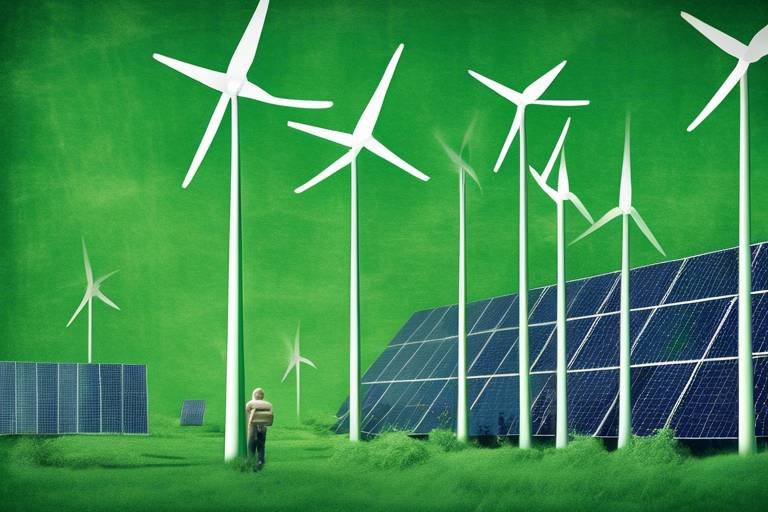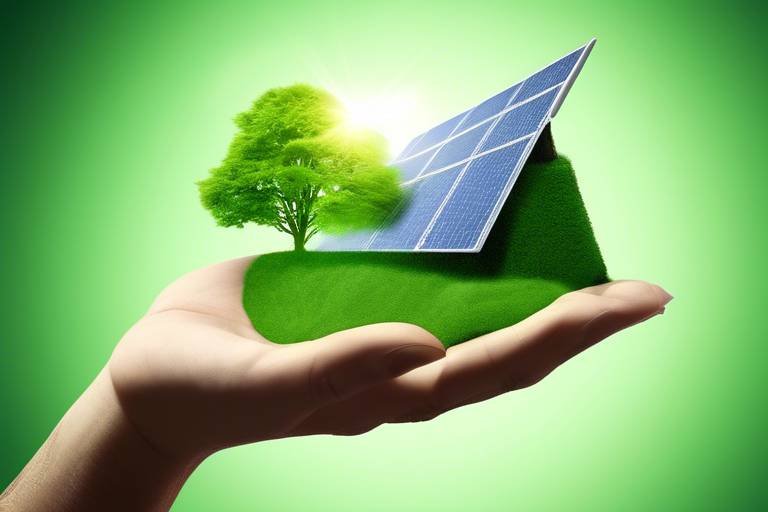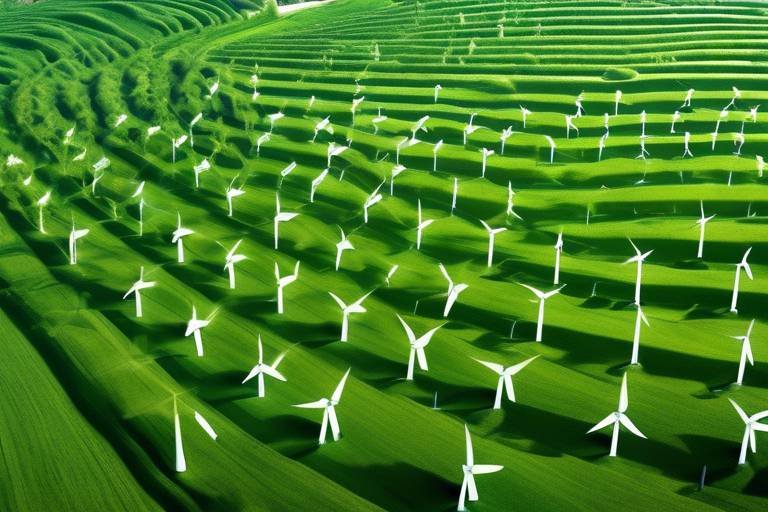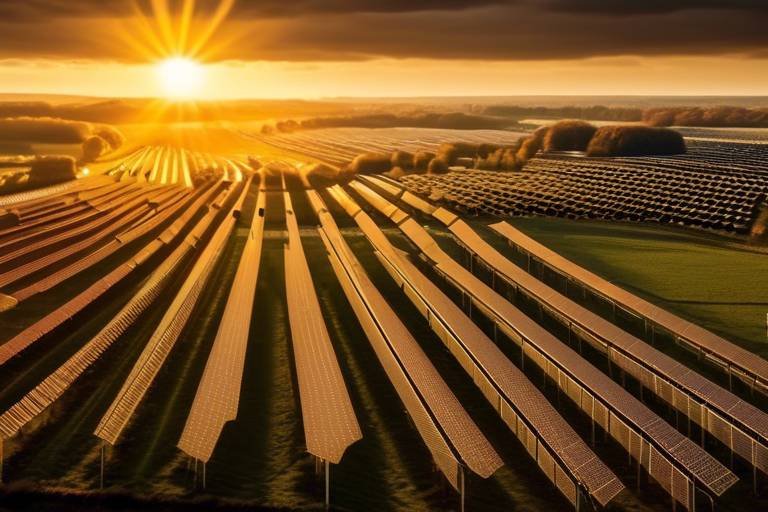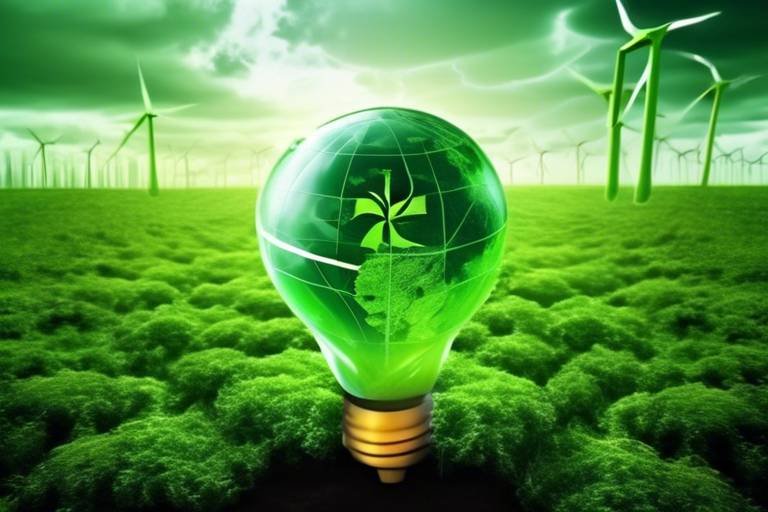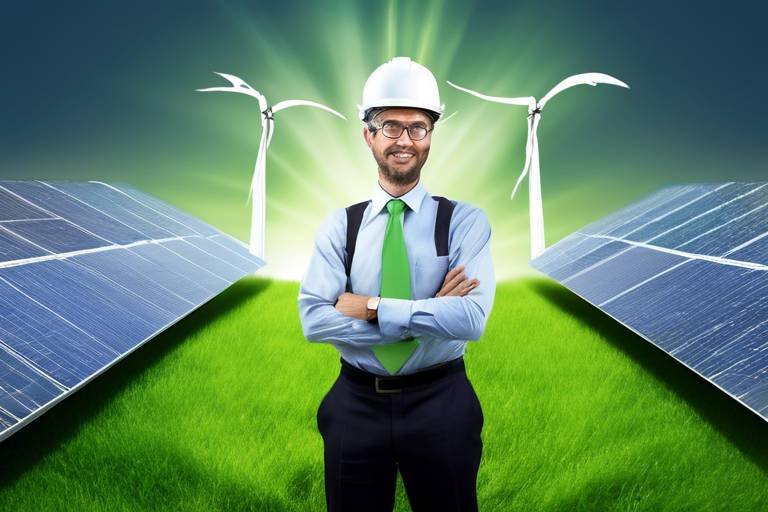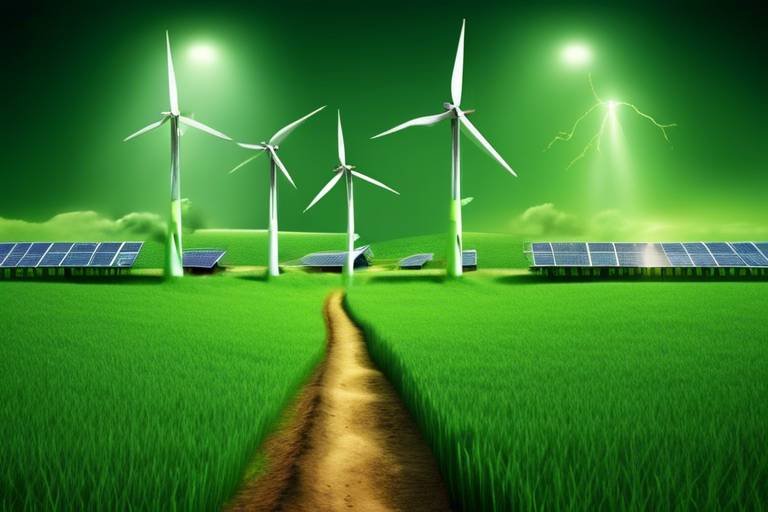Green Energy Solutions – An Analysis of Emerging Trends
In a world increasingly aware of the consequences of climate change, the shift towards green energy solutions has never been more critical. With the urgency to reduce carbon emissions and transition to sustainable energy sources, innovative technologies are emerging at a rapid pace. As we delve into the latest developments in green energy, we’ll uncover how these advancements not only aim to meet our energy demands but also play a pivotal role in preserving our planet for future generations. From solar power to wind energy, bioenergy to hydrogen fuel, each sector is witnessing exciting trends that promise to reshape our energy landscape.
Recent advancements in solar technology are revolutionizing energy generation. Solar panels have come a long way from their bulky, less efficient predecessors. Today, we’re seeing sleek designs that integrate seamlessly into buildings and even solar skins that mimic the appearance of traditional roofing materials. Enhanced efficiency is another significant leap forward; modern solar panels can convert sunlight into electricity with over 22% efficiency, a remarkable improvement that drastically reduces the space needed for solar farms. By harnessing the sun’s power, we not only cut down on our carbon footprints but also pave the way for a more sustainable energy future.
Wind energy is gaining momentum as a significant renewable resource. With new turbine technologies that are taller and more efficient, the potential for harnessing wind power is greater than ever. Offshore wind farms are becoming a common sight, taking advantage of stronger and more consistent winds found at sea. The economic benefits of wind energy are also noteworthy; the cost of wind power has plummeted by nearly 70% in the last decade, making it one of the most affordable energy sources available today. As we transition to greener solutions, the wind is indeed at our backs!
Floating wind turbine technology is enabling energy generation in deeper waters, where traditional turbines cannot operate effectively. This innovative approach presents a solution to some of the engineering challenges we face in offshore wind energy. By utilizing floating platforms, we can tap into vast areas of ocean that were previously off-limits, significantly increasing our energy output. The environmental advantages are also noteworthy; these floating turbines have a lower impact on marine ecosystems compared to their fixed counterparts.
Understanding the ecological effects of floating wind farms is crucial. While they offer numerous benefits, such as reduced carbon emissions and the generation of clean energy, we must also be mindful of their impact on marine life and coastal communities. Studies are ongoing to assess the potential disruptions to local ecosystems, but preliminary findings indicate that, when carefully sited, floating wind farms can coexist with marine habitats.
Cost reductions in floating wind technology are vital for scalability. As the technology matures, financial models are evolving to support these projects. Government incentives and subsidies are also playing a key role in making floating wind energy feasible. With ongoing investments and innovations, we can expect to see a significant increase in the deployment of floating wind farms in the coming years.
Community-driven wind energy projects empower local populations. These initiatives not only provide clean energy but also foster a sense of ownership and engagement among community members. Successful case studies from around the world demonstrate how local involvement can lead to social benefits, such as job creation and enhanced community cohesion. By investing in community wind projects, we are not just generating energy; we are building stronger, more resilient communities.
Bioenergy is emerging as a versatile renewable energy source. This segment investigates biomass, biogas, and their roles in sustainable energy production and waste management. Biomass energy crops, such as switchgrass and miscanthus, are being cultivated specifically for energy production. This not only provides a renewable energy source but also contributes to sustainable agriculture by utilizing land that may otherwise remain fallow.
Biogas production from organic waste is gaining traction. The technology involved in converting waste into energy is becoming more sophisticated, allowing for the efficient capture of methane from landfills and agricultural waste. This process not only reduces the amount of waste that ends up in landfills but also generates a valuable energy source that can be used for heating or electricity generation. Imagine turning your kitchen scraps into power for your home—it’s not just a dream anymore!
The cultivation of energy crops for biomass presents opportunities for sustainable agriculture. By selecting the right types of crops, we can enhance land use while also ensuring food security. The balance between energy production and food supply is delicate, but with careful planning and management, it is possible to achieve both goals. This dual approach to land use can help mitigate climate change while supporting local economies.
Hydrogen fuel is poised to play a critical role in the green energy landscape. As we explore production methods, storage solutions, and the potential for hydrogen as a clean energy carrier, it becomes clear that hydrogen could be the missing link in our transition to a sustainable future. With advancements in electrolyzers and fuel cell technology, hydrogen production is becoming more efficient and cost-effective, making it a viable option for various applications, from transportation to industrial processes.
- What are the main sources of green energy? The primary sources include solar, wind, hydro, biomass, and geothermal energy.
- How does solar energy help the environment? Solar energy reduces reliance on fossil fuels, lowers greenhouse gas emissions, and decreases air pollution.
- What is the future of wind energy? The future looks bright, with innovations like floating wind turbines and increased offshore installations expected to drive growth.
- Can bioenergy contribute to waste management? Yes, bioenergy can convert organic waste into energy, reducing landfill use and generating renewable energy.
- Is hydrogen fuel safe? When handled properly, hydrogen fuel is safe and can be a clean energy source with minimal environmental impact.

Solar Power Innovations
Recent advancements in solar technology are revolutionizing energy generation and making solar power more accessible and efficient than ever before. With the increasing demand for renewable energy sources, solar power has emerged as a frontrunner in the race towards sustainability. Innovations in solar panel designs, efficiency improvements, and energy storage solutions are paving the way for a cleaner, greener future. But what exactly are these innovations, and how do they contribute to reducing our carbon footprints?
One of the most exciting developments in solar power is the introduction of perovskite solar cells. These cells are made from a unique crystal structure that allows for higher efficiency rates at a lower production cost compared to traditional silicon-based solar panels. Imagine being able to harness the sun's energy more effectively while also decreasing manufacturing waste! Perovskite cells are not just a theoretical concept; they are already being tested in various pilot projects around the world, showing promising results.
Moreover, the integration of solar tracking systems enhances the performance of solar panels significantly. These systems adjust the angle of the panels throughout the day to maximize sunlight exposure. Think of it like a sunflower that follows the sun; by using this technology, energy generation can increase by up to 25% compared to stationary panels. This means more energy production without requiring additional land or resources.
Another noteworthy innovation is the development of solar shingles. These are not your traditional bulky solar panels but rather sleek, aesthetically pleasing shingles that blend seamlessly with your roof. Homeowners can now generate energy without compromising the visual appeal of their homes. This is a game-changer for those who want to adopt renewable energy but are concerned about the appearance of conventional solar installations.
To further enhance the efficiency of solar energy systems, researchers are also exploring the potential of energy storage solutions. With advancements in battery technology, solar energy can be stored for use during non-sunny hours, making it a reliable source of power. This is particularly important as we move towards a more decentralized energy grid where homes and businesses can produce and store their own energy. The combination of solar power generation and energy storage creates a more resilient energy system that can withstand fluctuations in supply and demand.
In summary, the innovations in solar power technology are not just incremental improvements; they represent a significant leap towards a sustainable future. As these technologies become more mainstream, we can expect to see a dramatic reduction in our reliance on fossil fuels. It's an exciting time for solar energy, and the potential for growth is immense. But as we embrace these innovations, we must also consider their impact on the environment and ensure that we are moving towards a truly sustainable energy future.
To wrap up this section, let's take a quick look at some key innovations in solar technology:
| Innovation | Description | Benefits |
|---|---|---|
| Perovskite Solar Cells | High-efficiency solar cells made from a unique crystal structure. | Lower costs and higher efficiency rates. |
| Solar Tracking Systems | Adjusts the angle of solar panels to maximize sunlight exposure. | Increases energy production by up to 25%. |
| Solar Shingles | Aesthetic solar panels that blend with roofing materials. | Generates energy without compromising visual appeal. |
| Energy Storage Solutions | Advanced battery technology for storing solar energy. | Provides reliable power during non-sunny hours. |
As we continue to innovate and improve upon these technologies, the future of solar energy looks brighter than ever. Stay tuned for more exciting developments in the world of renewable energy!

Wind Energy Developments
Wind energy is rapidly emerging as a significant player in the renewable energy landscape. With the world increasingly turning its focus towards sustainable solutions, the advancements in wind technology are nothing short of revolutionary. The latest innovations in turbine design, coupled with the expansion of offshore wind farms, are paving the way for a cleaner, greener future. But what does this mean for us? Let’s dive deeper into these exciting developments!
One of the most remarkable advancements in wind energy is the improvement in turbine efficiency. Modern turbines are not only larger but also smarter. They can capture wind energy more effectively, even in lower wind speeds. This efficiency boost translates to more energy produced per turbine, making wind energy a more viable option for both large-scale and community-based projects. According to recent studies, the energy output of new turbines can be up to 50% higher than their predecessors, which is a game-changer in the industry.
Offshore wind farms are another area witnessing explosive growth. These installations take advantage of the stronger and more consistent winds found over the oceans. The technology is evolving rapidly, with countries like Denmark and the UK leading the charge. The sheer scale of these projects can be staggering; for instance, the Hornsea One project in the UK is set to power over 1 million homes with its 1.2 GW capacity. Imagine the positive impact on carbon emissions when such projects come online!
One of the most exciting innovations in offshore wind energy is the development of floating wind turbines. These structures are designed to be anchored to the seabed, allowing them to operate in deeper waters where traditional fixed turbines cannot be installed. This opens up vast areas for wind energy generation that were previously untapped due to engineering challenges. Floating turbines can harness stronger winds and are less affected by the rough conditions that often plague coastal installations.
But before we get too carried away with the potential, we must consider the environmental impact of floating wind farms. While they promise significant benefits, such as reduced visual pollution and the ability to avoid sensitive coastal ecosystems, they also pose risks to marine life. Studies are ongoing to assess how these structures affect local wildlife, particularly migratory birds and marine mammals. Balancing the need for renewable energy with ecological preservation is a challenge that engineers and environmentalists are actively addressing.
Cost is another critical factor in the scalability of floating wind technology. The initial investment can be substantial, but advancements in engineering and manufacturing are driving costs down. Financial models are evolving, and government incentives are making these projects more feasible. In fact, recent reports indicate that costs for floating wind projects could drop by as much as 30% over the next decade. This reduction could make floating wind energy competitive with traditional energy sources, which is essential for widespread adoption.
Community-driven wind energy projects are also gaining traction, empowering local populations to take charge of their energy needs. These projects not only provide renewable energy but also foster a sense of ownership and pride among community members. Successful case studies from various regions highlight the social benefits of such initiatives, including job creation and local economic boosts. When communities come together to invest in renewable energy, the results can be both economically and environmentally beneficial.
In summary, the developments in wind energy are paving the way for a sustainable future. With innovations in turbine technology, the expansion of offshore wind farms, and the rise of community projects, wind energy is set to play a vital role in our transition to a greener planet. As we continue to explore these advancements, it’s crucial to remain mindful of their environmental impacts and strive for solutions that benefit both people and the planet.
- What are the main benefits of wind energy?
Wind energy is renewable, reduces greenhouse gas emissions, and can create jobs in local communities. - How do floating wind turbines work?
Floating wind turbines are anchored to the seabed and can operate in deeper waters, capturing stronger winds. - What is the future of wind energy?
The future looks promising with advancements in technology and decreasing costs, making wind energy more accessible and efficient.

Floating Wind Turbines
Floating wind turbine technology is an exciting frontier in the renewable energy sector, enabling us to harness the power of wind in deeper waters where traditional fixed turbines cannot operate. Imagine the vast potential of generating energy from the open sea, where wind speeds are often higher and more consistent. This innovation not only enhances energy production capabilities but also presents a solution to the spatial constraints faced by onshore wind farms. With the ocean covering over 70% of our planet, the possibilities are endless!
One of the key engineering challenges of floating wind turbines lies in their design and stability. These turbines are anchored to the seabed using a variety of mooring systems, ensuring they remain secure against strong ocean currents and storms. The structures are typically built on platforms that float on the water's surface, allowing them to move with the waves while maintaining their position. This unique design requires advanced materials and engineering techniques to withstand harsh marine conditions, making it a fascinating area of research and development.
The environmental advantages of floating wind turbines are significant. By positioning turbines further offshore, we can minimize visual and noise pollution for coastal communities, which is often a concern with onshore installations. Additionally, these offshore wind farms can contribute to biodiversity by creating artificial reefs, providing habitats for marine life. However, it is crucial to conduct thorough environmental assessments to mitigate any potential negative impacts on marine ecosystems.
Cost efficiency is another vital aspect of floating wind technology. While the initial investment can be high, advancements in engineering and economies of scale are driving down costs. Governments around the world are recognizing this potential and are offering financial incentives to support the development of floating wind farms. The table below illustrates some of the key factors influencing the cost efficiency of these projects:
| Factor | Impact on Cost |
|---|---|
| Technology Advancements | Reduces material and construction costs |
| Government Incentives | Encourages investment and lowers financial risks |
| Operational Efficiency | Increases energy output and reduces maintenance costs |
| Scale of Projects | Lower costs per unit through larger installations |
In conclusion, floating wind turbines represent a groundbreaking approach to renewable energy generation. They not only address the limitations of traditional wind farms but also offer a sustainable solution to meet our growing energy demands. As technology continues to evolve, we can expect to see more innovative designs and increased investment in this promising sector. The future of energy could very well be floating on the waves!
- What are floating wind turbines? Floating wind turbines are offshore wind energy systems that are not fixed to the seabed, allowing them to be deployed in deeper waters.
- How do floating wind turbines work? They use buoyant platforms to support the turbines, which are anchored to the seabed, enabling them to capture wind energy efficiently.
- What are the environmental impacts of floating wind farms? While they can minimize visual and noise pollution, it's essential to conduct environmental assessments to understand their effects on marine ecosystems.
- Are floating wind turbines cost-effective? Yes, ongoing advancements in technology and government incentives are making floating wind farms increasingly cost-effective.

Environmental Impact
The deployment of floating wind farms represents a fascinating intersection of technology and environmental stewardship. As these innovative structures rise above the waves, they not only harness the power of the wind but also carry significant implications for marine ecosystems and coastal communities. One of the most pressing concerns is the potential impact on marine life. For instance, the noise generated during the installation and operation of floating turbines can disrupt the natural behaviors of marine species, particularly mammals like whales and dolphins, which rely on sound for communication and navigation.
However, it's not all doom and gloom. Floating wind farms can also serve as artificial reefs, offering new habitats for various marine organisms. This duality of impact underscores the importance of thorough environmental assessments prior to project initiation. Researchers are increasingly employing advanced modeling techniques to predict how these structures will interact with local ecosystems. This proactive approach can help mitigate negative consequences while enhancing the positive aspects of floating wind technology.
Moreover, the environmental benefits of floating wind farms extend beyond marine life. By generating clean energy offshore, these projects significantly reduce greenhouse gas emissions compared to fossil fuel sources. According to recent studies, a single floating wind farm can offset hundreds of thousands of tons of carbon dioxide annually, contributing to global efforts to combat climate change. This reduction in carbon footprint is crucial as we strive for a more sustainable future.
In terms of coastal communities, floating wind farms can also play a vital role in economic development. They can create local jobs during both the construction and operational phases, fostering a sense of community involvement and ownership. Additionally, the revenue generated from these projects can be reinvested into local infrastructure, education, and conservation efforts, creating a win-win scenario for both the environment and the community.
In summary, while the environmental impact of floating wind farms presents challenges, it also offers numerous opportunities for enhancing marine ecosystems and supporting sustainable energy production. The key lies in careful planning, ongoing research, and community engagement to ensure that these projects are developed responsibly and beneficially.
- What are floating wind farms? Floating wind farms are offshore wind energy installations that are anchored to the seabed but float on the water's surface, allowing them to be placed in deeper waters where traditional fixed turbines cannot be installed.
- How do floating wind farms impact marine life? They can disrupt marine life through noise pollution during installation and operation but can also provide new habitats for marine organisms, acting as artificial reefs.
- What are the economic benefits of floating wind farms? These projects can create local jobs, stimulate economic growth, and generate revenue for communities, which can be reinvested into local services and infrastructure.
- How do floating wind farms contribute to sustainability? By generating clean energy, floating wind farms significantly reduce greenhouse gas emissions, helping to mitigate climate change and promote a sustainable energy future.

Cost Efficiency
In the world of renewable energy, is not just a buzzword; it's a game changer. As the technology behind floating wind turbines continues to evolve, the financial landscape of these projects is becoming increasingly favorable. One of the key factors driving this trend is the significant reduction in the cost of offshore wind energy. According to recent studies, the cost of electricity generated from offshore wind has dropped by over 50% in the last decade, making it a competitive alternative to fossil fuels.
But what exactly contributes to this ? Several elements play a crucial role:
- Economies of Scale: As more floating wind farms are developed, manufacturers are able to produce turbines at a larger scale, reducing per-unit costs.
- Technological Advancements: Innovations in turbine design and materials have led to lighter, more efficient turbines that require less maintenance and have longer lifespans.
- Government Incentives: Many governments are offering subsidies and tax breaks for renewable energy projects, which can significantly reduce upfront costs.
- Improved Grid Integration: Enhancements in grid technology allow for better integration of renewable energy sources, reducing transmission losses and improving overall efficiency.
To illustrate the impact of these factors, consider the following
| Year | Cost of Offshore Wind Energy (per MWh) |
|---|---|
| 2010 | $180 |
| 2015 | $120 |
| 2020 | $70 |
| 2025 (Projected) | $50 |
This table highlights the dramatic decrease in costs over the years, showcasing the potential for floating wind technology to become even more affordable in the near future. The implications of these cost reductions are profound. As projects become more financially viable, investment in floating wind farms is likely to surge, leading to greater energy independence and a significant reduction in greenhouse gas emissions.
Moreover, the economic benefits extend beyond just the energy sector. Communities that host these projects often see an influx of jobs, from construction to maintenance, fostering local economies. Additionally, the creation of a sustainable energy source can lead to lower energy prices for consumers, further enhancing the appeal of floating wind technology.
In conclusion, the of floating wind turbines is a critical factor that will determine the success of renewable energy initiatives in the coming years. As technology continues to advance and costs decline, we can expect to see a significant shift towards more sustainable energy solutions that not only benefit the environment but also promote economic growth.
- What are floating wind turbines? Floating wind turbines are offshore wind energy systems that are anchored to the seabed and can operate in deeper waters where traditional fixed turbines cannot.
- How do floating wind turbines benefit the environment? They reduce carbon emissions by providing a renewable energy source, and their design minimizes impact on marine ecosystems compared to traditional turbines.
- Are floating wind farms cost-effective? Yes, advancements in technology and government incentives are making floating wind farms increasingly cost-effective compared to fossil fuels.

Community Wind Projects
Community wind projects represent a transformative approach to renewable energy, allowing local populations to take charge of their energy needs while simultaneously fostering a sense of ownership and responsibility towards the environment. These initiatives not only empower communities but also create a ripple effect of benefits that extend far beyond the immediate energy produced. Imagine a small town where the residents collectively invest in wind turbines, generating clean energy that powers their homes, schools, and businesses. This is not just a dream; it's a reality in many areas around the globe.
One of the most compelling aspects of community wind projects is their ability to engage local stakeholders. When a community comes together to develop a wind farm, it fosters collaboration and strengthens social bonds. Residents can participate in decision-making processes, ensuring that the project aligns with their values and needs. Furthermore, these projects often lead to job creation, as local workers are employed during the construction and maintenance phases. This not only boosts the local economy but also enhances the community's resilience against economic downturns.
Successful case studies from various regions illustrate the potential of community wind projects. For instance, in the United States, the Blue Sky Wind Farm in Minnesota has become a model for community engagement. Funded by local investors, this project has not only provided clean energy but has also contributed to the local economy by creating jobs and increasing tax revenues. Similarly, in Denmark, community-owned wind farms supply a significant portion of the country's energy needs, demonstrating how collective action can lead to substantial environmental and economic benefits.
Moreover, community wind projects can significantly enhance public awareness and support for renewable energy. When individuals see the tangible benefits of wind energy in their own backyards, they are more likely to advocate for sustainable practices and policies. This grassroots movement can lead to broader changes in energy policy at the local and national levels, pushing for more investments in renewable energy sources and reducing reliance on fossil fuels.
However, it's essential to recognize that these projects are not without challenges. Issues such as securing financing, navigating regulatory hurdles, and addressing potential opposition from local residents who may have concerns about noise or visual impacts are common. To mitigate these challenges, effective communication and transparency are crucial. Engaging the community from the outset and addressing concerns can help build trust and support for the project.
In conclusion, community wind projects are a shining example of how local engagement in renewable energy can lead to sustainable and equitable outcomes. By harnessing the power of wind, communities not only reduce their carbon footprint but also create a more resilient and economically vibrant future. As we look towards a greener tomorrow, these initiatives will undoubtedly play a critical role in shaping our energy landscape.
- What are community wind projects?
Community wind projects are renewable energy initiatives where local residents come together to develop and manage wind farms, allowing them to generate clean energy for their own use. - How do community wind projects benefit local economies?
These projects create jobs during construction and maintenance, increase local tax revenues, and stimulate local businesses by providing a reliable energy source. - What challenges do community wind projects face?
Challenges include securing financing, navigating regulatory requirements, and addressing community concerns regarding noise and visual impacts. - How can communities get involved in wind energy?
Communities can start by forming local groups to assess interest, explore funding options, and engage with experts in renewable energy development.

Bioenergy Solutions
Bioenergy is rapidly emerging as a versatile renewable energy source, offering a multitude of solutions for sustainable energy production and waste management. At its core, bioenergy harnesses energy from organic materials, which can be derived from various sources such as agricultural residues, forestry by-products, and even municipal waste. This approach not only contributes to energy generation but also plays a crucial role in reducing waste and promoting environmental sustainability. Imagine transforming what would typically be discarded into a valuable energy resource; that’s the magic of bioenergy!
One of the most significant aspects of bioenergy is its dual role in addressing energy needs while simultaneously tackling waste management challenges. By converting organic waste into energy, we can significantly reduce the amount of waste that ends up in landfills, which in turn decreases methane emissions—a potent greenhouse gas. As we delve deeper into the world of bioenergy, we’ll explore two key components: biomass and biogas.
Biogas production is gaining traction as a sustainable method for generating energy. This process involves the anaerobic digestion of organic materials, such as food scraps and agricultural waste, to produce methane-rich biogas. This biogas can then be used for heating, electricity generation, or even as a vehicle fuel. The technology behind biogas production has advanced significantly, making it more efficient and accessible. For instance, modern digesters can handle a variety of feedstocks, allowing for greater flexibility in production.
Moreover, biogas systems contribute to waste reduction by diverting organic materials from landfills. This not only mitigates greenhouse gas emissions but also provides a renewable energy source that can be utilized locally, fostering energy independence. The potential for biogas production is enormous, with estimates suggesting that it could supply a substantial portion of the energy needs for many communities. Just think about the impact of turning waste into a clean energy source—it's like hitting two birds with one stone!
The cultivation of energy crops for biomass is another exciting avenue in the bioenergy landscape. These crops, which include species like switchgrass, miscanthus, and various types of wood, are specifically grown to produce energy. What’s fascinating about biomass energy crops is their ability to provide a sustainable source of fuel while also enhancing soil health and biodiversity. By selecting the right crops, farmers can optimize land use without compromising food security.
It's essential to note that the integration of biomass energy crops into agricultural systems can lead to numerous benefits. For example, these crops can be grown on marginal lands—areas not suitable for food production—thereby minimizing competition with food crops. Additionally, the cultivation of energy crops can promote rural development by creating jobs and supporting local economies. As we explore the future of bioenergy, the role of biomass energy crops will undoubtedly be pivotal in achieving a sustainable energy transition.
| Type of Bioenergy | Description | Benefits |
|---|---|---|
| Biogas | Produced from anaerobic digestion of organic materials. | Reduces waste, generates renewable energy, lowers greenhouse gas emissions. |
| Biomass Energy Crops | Crops grown specifically for energy production. | Optimizes land use, supports rural economies, enhances soil health. |
- What is bioenergy? Bioenergy is energy derived from organic materials, including plant and animal waste.
- How is biogas produced? Biogas is produced through the anaerobic digestion of organic materials, which breaks them down in the absence of oxygen.
- Are biomass energy crops sustainable? Yes, when managed properly, biomass energy crops can be sustainable and provide environmental benefits.
- What are the environmental benefits of bioenergy? Bioenergy reduces waste, lowers greenhouse gas emissions, and can promote soil health and biodiversity.

Biogas Production
Biogas production has emerged as a revolutionary method for converting organic waste into valuable energy. This process primarily involves the anaerobic digestion of organic materials such as agricultural residues, food waste, and animal manure. By harnessing the natural decomposition processes, biogas facilities can generate a renewable energy source that not only reduces waste but also contributes to sustainability efforts.
One of the most compelling aspects of biogas production is its dual benefit: it provides a clean energy source while simultaneously addressing waste management challenges. The biogas produced is primarily composed of methane and carbon dioxide, with methane being the key component that can be used for heating, electricity generation, and even as a vehicle fuel. The process not only mitigates greenhouse gas emissions but also creates a nutrient-rich digestate, which can be used as a fertilizer, enhancing soil health.
To give you a clearer picture of how biogas production works, let’s break down the process into key steps:
- Feedstock Collection: Organic materials are collected from various sources, including farms, food processing plants, and households.
- Anaerobic Digestion: The collected feedstock is placed in a sealed tank, where microorganisms break it down in the absence of oxygen, producing biogas.
- Biogas Collection: The generated biogas is captured and can be processed further to remove impurities.
- Energy Utilization: The purified biogas can be used for heating, electricity generation, or upgraded to biomethane for use in natural gas grids or as vehicle fuel.
Moreover, the technology for biogas production has advanced significantly over recent years. Innovations in digester design and monitoring systems have improved efficiency and output. For instance, the use of continuous stirred-tank reactors allows for a more uniform mixing of feedstock, enhancing the digestion process and increasing biogas yield. Additionally, advancements in biogas upgrading technologies enable the removal of carbon dioxide and other impurities, resulting in high-purity biomethane that can compete with fossil fuels.
Despite its benefits, biogas production does face challenges. Factors such as the availability of feedstock, initial investment costs, and regulatory hurdles can impede the growth of biogas facilities. However, as governments and organizations increasingly recognize the importance of renewable energy, there are more incentives and funding opportunities available to support biogas projects.
In summary, biogas production is not just a waste management solution; it represents a significant step towards a more sustainable energy future. By converting organic waste into a renewable energy source, we can reduce our reliance on fossil fuels, minimize environmental impact, and contribute to a circular economy.
- What types of organic waste can be used for biogas production?
Common feedstocks include agricultural residues, food waste, animal manure, and even sewage sludge.
- Is biogas production environmentally friendly?
Yes, it helps reduce greenhouse gas emissions and provides a renewable energy source while managing organic waste.
- Can biogas be used for vehicles?
Absolutely! Upgraded biogas, known as biomethane, can be used as a clean fuel for vehicles.

Biomass Energy Crops
Biomass energy crops are an exciting frontier in the quest for sustainable energy solutions. These crops are specifically grown to produce energy, either through direct combustion or by conversion into biofuels. Unlike traditional crops, which are primarily cultivated for food, biomass energy crops focus on maximizing energy yield while minimizing environmental impact. This innovative approach not only contributes to energy production but also plays a significant role in enhancing soil health and biodiversity.
One of the most common types of biomass energy crops includes miscanthus, a perennial grass known for its high yield and low input requirements. Miscanthus can produce up to 15 tons of biomass per hectare annually, making it a standout choice for energy production. Additionally, it requires less water and fertilizer compared to conventional crops, which is a significant advantage in regions facing water scarcity.
Another popular option is switchgrass, which is native to North America. This hardy grass is not only resilient but also helps in improving soil quality through its deep root systems. By planting switchgrass, farmers can combat soil erosion while simultaneously producing a renewable energy source. The cultivation of these energy crops represents a win-win situation for farmers and the environment alike.
When considering the impact of biomass energy crops, it's essential to address the balance between energy production and food security. Some critics argue that dedicating land to energy crops may compete with food production. However, many studies suggest that utilizing marginal lands—areas unsuitable for food crops—can mitigate this issue. This practice not only optimizes land use but also contributes to local economies through job creation in the bioenergy sector.
To further illustrate the potential of biomass energy crops, let’s take a look at the following table that summarizes some of the key biomass crops and their attributes:
| Crop Type | Average Yield (tons/ha/year) | Water Requirement | Soil Improvement |
|---|---|---|---|
| Miscanthus | 15 | Low | Yes |
| Switchgrass | 8-10 | Moderate | Yes |
| Giant Reed | 20 | Moderate | Yes |
In conclusion, biomass energy crops offer a promising avenue for diversifying energy sources while promoting sustainable agricultural practices. As technology advances and more research is conducted, the potential for these crops to contribute significantly to the renewable energy landscape becomes increasingly evident. By investing in biomass energy crops, we can pave the way for a greener, more sustainable future.
- What are biomass energy crops? Biomass energy crops are plants specifically cultivated for energy production, either through combustion or conversion into biofuels.
- How do biomass crops impact food security? While there is concern about competition with food crops, utilizing marginal lands for biomass can help mitigate this issue.
- What are some examples of biomass energy crops? Common examples include miscanthus, switchgrass, and giant reed.
- Can biomass crops improve soil health? Yes, many biomass crops have deep root systems that help improve soil quality and prevent erosion.

Hydrogen Fuel Advances
Hydrogen fuel is rapidly becoming a game-changer in the quest for sustainable energy solutions. With its ability to produce clean energy, hydrogen is gaining traction as a vital component of the green energy landscape. But what exactly makes hydrogen fuel so appealing? For starters, when hydrogen combusts, it only emits water vapor, making it an incredibly clean energy source. This characteristic is particularly important as we strive to reduce greenhouse gas emissions and combat climate change.
One of the most exciting developments in hydrogen fuel technology is the variety of production methods that are emerging. Traditionally, hydrogen has been produced through a process called steam methane reforming, which involves extracting hydrogen from natural gas. However, this method is not entirely green. Fortunately, advancements in electrolysis technology are changing the game. Electrolysis involves using electricity to split water into hydrogen and oxygen, and when powered by renewable energy sources, this method can produce green hydrogen, which is entirely sustainable.
Another noteworthy advancement is the development of hydrogen storage solutions. Storing hydrogen has been a significant challenge due to its low density. However, innovative techniques such as metal hydrides and high-pressure tanks are making it easier to store and transport hydrogen safely. This is crucial because, for hydrogen to become a viable alternative to fossil fuels, we need efficient ways to store and distribute it. For instance, the table below illustrates some of the current hydrogen storage technologies and their respective advantages:
| Storage Technology | Advantages |
|---|---|
| Compressed Hydrogen | Simple and well-established technology; suitable for transport. |
| Liquid Hydrogen | High energy density; ideal for large-scale storage. |
| Metal Hydrides | Safe and compact; can operate at lower pressures. |
As we look towards the future, the potential for hydrogen as a clean energy carrier is immense. It can be used in various sectors, including transportation, heating, and even industrial processes. Imagine a world where our cars run on hydrogen fuel cells, emitting nothing but water vapor. This vision is becoming increasingly feasible as automobile manufacturers invest in hydrogen fuel technology, with several companies already releasing hydrogen-powered vehicles.
Moreover, hydrogen can play a crucial role in energy storage solutions. As we continue to expand renewable energy sources like solar and wind, we face the challenge of energy intermittency. Hydrogen can act as a storage medium, allowing excess energy to be converted into hydrogen during peak production times and then used later when energy demand is high. This creates a sustainable energy cycle that enhances the reliability of renewable energy systems.
Despite the promising advancements, there are still hurdles to overcome. The infrastructure for hydrogen production, storage, and distribution is not as developed as that for fossil fuels. However, governments and private sectors are beginning to recognize the importance of hydrogen and are investing in the necessary infrastructure. Initiatives such as hydrogen refueling stations are popping up, making it easier for consumers to adopt hydrogen-powered vehicles.
In conclusion, hydrogen fuel advances are paving the way for a cleaner, more sustainable energy future. With continued innovation in production methods, storage solutions, and infrastructure development, hydrogen holds the potential to revolutionize how we think about energy. As we embrace this transformative technology, we can look forward to a world where clean, renewable energy is the norm, not the exception.
- What is hydrogen fuel? Hydrogen fuel is a clean energy source produced from hydrogen, which, when used, emits only water vapor.
- How is hydrogen produced? Hydrogen can be produced through various methods, including steam methane reforming and electrolysis.
- What are the benefits of hydrogen fuel? Hydrogen fuel is environmentally friendly, versatile, and can be used in multiple sectors, including transportation and energy storage.
- What challenges does hydrogen fuel face? The main challenges include developing infrastructure for production, storage, and distribution, as well as reducing production costs.
Frequently Asked Questions
- What are the latest innovations in solar power technology?
Recent advancements in solar power include enhanced solar panel designs that improve energy efficiency and durability. Innovations like bifacial panels and solar tracking systems are allowing for greater energy capture, making solar power a more viable option for reducing carbon footprints.
- How do floating wind turbines work?
Floating wind turbines are anchored to the seabed but float on the water's surface, allowing them to harness wind energy in deeper waters where traditional turbines can't be installed. This technology faces engineering challenges but offers significant environmental advantages, such as reduced visual impact and less interference with marine ecosystems.
- What are the benefits of community wind projects?
Community wind projects empower local populations by involving them in renewable energy initiatives. They can lead to economic benefits, job creation, and increased local investment, fostering a sense of ownership and responsibility towards sustainable practices.
- How is biogas produced?
Biogas is produced through the anaerobic digestion of organic waste, such as food scraps and agricultural residues. This process not only generates energy but also significantly reduces waste, contributing to a more sustainable waste management system.
- What types of crops are used for biomass energy?
Common energy crops for biomass include switchgrass, miscanthus, and certain types of corn. These crops are chosen for their high yield and ability to grow on marginal lands, helping to balance energy production with food security and land use concerns.
- What is the potential of hydrogen fuel in green energy?
Hydrogen fuel has immense potential as a clean energy carrier. It can be produced from various sources, including water and natural gas, and can be stored and transported easily. This versatility positions hydrogen as a key player in the transition to sustainable energy systems.

